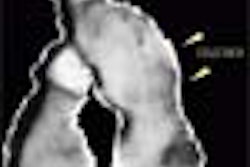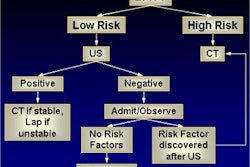MONTREAL - Focused abdominal sonography for trauma (FAST) is changing emergency room procedure in major trauma centers across the U.S., according to a presentation at the congress of the World Federation for Ultrasound in Medicine and Biology and the American Institute of Ultrasound in Medicine.
"It’s a new thing and it’s still evolving," said Dr. John McGahan during his talk Monday. While CT remains the gold standard in the evaluation of abdominal trauma, FAST ultrasound is clearly superior in the initial evaluation of unstable patients, said McGahan, who is the director of abdominal imaging and ultrasound radiology at the University of California Davis Medical Center in Sacramento.
The FAST exam is a screening test designed to quickly identify free fluid, such as blood, in the right and left upper and lower quadrants, and in the pelvis.
"In the case of a trauma patient who is unstable, FAST saves lives, there’s no doubt about that. In the triage of these patients, if an ultrasound exam identifies free fluid, that patient goes straight to the operating room," McGahan told AuntMinnie.com.
FAST ultrasound has a number of advantages over CT: It’s less expensive, less time-consuming, and is a widely available modality, McGahan said. In addition, the technique’s lack of radiation makes sonography a more attractive option for certain patients, such as pregnant women and children.
McGahan acknowledged that CT scanning is superior to ultrasound in its ability to detect more injuries, particularly solid organ injuries such as liver, spleen, and pancreatic traumas. A patient with a negative FAST ultrasound exam would still be sent for a CT, he added.
But the center of the debate over these two procedures rests in the stable trauma patients.
Should all blunt traumas get a CT scan as long as they are stable? Yes, said Dr. Philip Ralls, professor of radiology at the Keck School of Medicine, University of Southern California in Los Angeles.
"Why would you go for ultrasound, an insensitive test that is technically difficult, versus CT scanning, which is a sensitive test that requires less expertise?" Ralls asked.
Ralls noted ultrasound's lack of sensitivity; a negative FAST ultrasound scan does not exclude pathology, he said. A patient initially imaged with ultrasound will likely remain in the hospital for observation and will still have to undergo a CT scan if their condition worsens -- an expensive proposition compared to immediate CT scanning, which clears many patients for discharge, Ralls said.
While Ralls and McGahan agreed that there is a role for FAST ultrasound in the modern trauma center, for the time being, physician preference will determine which modality is used first.
By Kate JohnsonAuntMinnie.com contributing writer
June 3, 2003
Related Reading
X-ray: first line of interpretation for unstable pelvic fractures, May 9, 2003
Filmless ED can open the door for enterprise-wide PACS, May 9, 2003
General radiologists go head-to head with neurorads in after-hours ER CT interpretation, May 8, 2003
Screening ultrasound has specific limitations in abdominal trauma, May 1, 2003
Ultrasound differentiates causes of abdominal pain in kids, October 4, 2002
Copyright © 2003 AuntMinnie.com



















